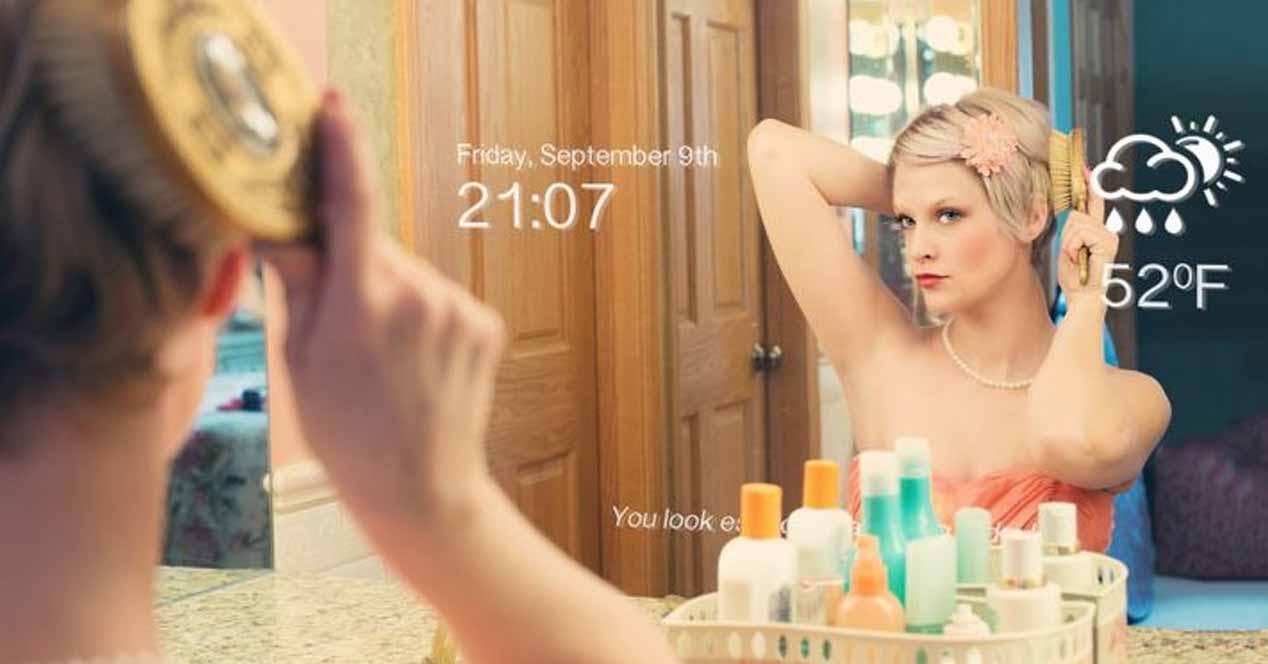A smart mirror is, as the name suggests in English, a smart mirror capable of showing you the time, date, outdoor weather, upcoming appointments on your calendar and much more while showing you, well sure, your own reflection. If you feel like it and have enough time and skills, you can even integrate a voice assistant and introduce as many components as you want, but that will be up to you.
What does it take to create a Smart Mirror?
Creating a Smart Mirror project will cost you around 300 dollars if you plan to start from scratch, but if you enjoy a Raspberry Pi that you had in a drawer dead with disgust without using it and a mirror that you already had in your home. , the price of the bill can be reduced considerably and for less than 100 dollars you could have it. Obviously, you can also spend more money, depending on whether you want to buy a new mirror, whether you want to integrate a microphone and speakers so that it is also a virtual assistant, etc.
As we indicated at the beginning, the main component of this project is a Raspberry pie, because in essence a Smart Mirror is nothing more than a mirror with a screen behind which must be controlled by “something”, and that something is the Raspberry, a small mini PC which hardly takes up space and is able to run Linux operating systems based on huge support from the developer community. In general, any model should work for you, but it is recommended that you use a Raspberry Pi 4
No matter what type of Smart Mirror you plan to build, you will need a series of items that are common to all projects of this nature, so we are going to list the minimum components you will need below.
What we have in our hands is a smart mirror, so obviously you will need a mirror (surprise!), But a normal mirror will not do you but one of the so-called bidirectional (On the one hand it reflects the image but on the other hand you can see what is on the other side), because we will need to see the image of the monitor that we will place from behind. Ideally, you should go to a hardware store or simil ar to order it, as it has the same dimensions as the screen you place behind, and that’s the next thing we’ll cover.
As we mentioned, it is necessary to place a screen behind the one-way mirror, which will be responsible for displaying the information; his thing is to put a LCD screen an old monitor you already own (still a flat screen, of course), and the size of that screen will depend on the size of the one-way mirror you need to order. The size you want to use is up to you, and in fact, you can even use an older Android tablet if you want.
Another common item you will need is a marc, preferably from wood because if it was metallic you could not customize it for the wiring that you will have to put. The frame is needed both for aesthetics and to accommodate “hidden” components, as well as to be able to hang the mirror on a wall. Obviously, you will also need basic tools such as screwdrivers, screws, sandpaper, carpentry tools, etc.
How to make a smart mirror with a Raspberry Pi?
As we mentioned at the start, there are many ways and options you have to create a Raspberry Pi based smart mirror, so what we’re going to do is list the already completed projects that we think are the most interesting than you. can take. the ideas you need depending on the type you intend to make.
We start with the original Smart Mirror, created by Michael Teeuw and called MagicMirror². As this was one of the first Smart Mirrors ever made, everything is very well documented in a series of tutorials written by the author, so you will have no problem making your own project as long as you are a little DIYer, since it is all explained in a simple way. The default modules include a clock, calendar, weather forecast, and courtesy message, and it’s all built in, you don’t even need to configure the Raspberry.
On the other hand, we also have the project Mirror mirror made by Dylan Pierce, and is considered by the entire DIY community as the best guide to creating a smart mirror from scratch. Pierce broke with the standard and configured Chromium to run on startup after installing Raspbian, but in any case, we recommend that you read the full post we linked to before you start building. yours, because it has certain nuances to take into account.
On the other hand, we also have a project that allows us to interact with the Smart Mirror using voice commands, in this case adding an Android smartphone or tablet to the equation. The project is being done by Evan Cohen, who provided extensive documentation on how to build, install, and use your smart mirror. Here is a video where you can see how it works.
Finally, the last project we want to highlight is built by Eben Kouao, and it’s not only a smart mirror with a touchscreen but it also has a built-in facial ID to identify the person in front of it. Building a smart mirror with a touchscreen is neither easy nor cheap as the thickness of the one-way mirror makes it impossible to use a standard capacitive screen, but Eben has incorporated an infrared frame for this touch capability, with a LED on one side and light detectors on the other, so you can tell where it was hit in the mirror.
With the inclusion of the camera module for the Raspberry Pi, the mirror can see the user and identify them using an OpenCV face detection module. You have all the documentation on this web page.












